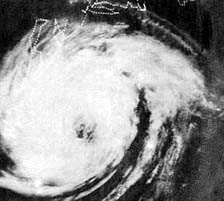
On June 9, 1966, Hurricane Alma struck the Florida panhandle, making it the earliest hurricane landfall on the continental United States since 1825.
Alma began as a tropical depression forming over Nicaragua on June 4th from an upper-level trough building down to the surface. It began to move northward, over Honduras and into the western Caribbean Sea. As it tracked slowly to the NNW it rapidly gained strength over the warm waters. By the time it passed over the Isle of Pines its winds reached 100 mph (160 km/hr). Alma actually gained strength as it passed over the western tip of Cuba. By the time it passed between Key West and the Dry Tortugas, its maximum winds had reached peak values of 125 mph (200 km/hr).

As the hurricane gained forward speed it swerved away from the southwestern Florida coast. Its winds diminished to 90 mph (140 km/hr) by the time it made landfall near Apalachee Bay in the Florida panhandle on the afternoon of June 9th. This was the earliest a hurricane had struck the mainland United States in over 140 years.
Shortly after landfall, Alma slowed and turned northeastward as it weakened into a tropical storm. It moved slowly off the coast of Georgia and South Carolina, but once it was far enough out to sea, it regained hurricane strength and its eye reformed. While east of the Outer Banks, the storm turned northward and approached New England and became more disorganized. Alma eventually dissipated as an extratropical low over Massachusetts,
During its course, Alma killed over 90 people and caused some US$210 million in damage. Most of the deaths were due to flash floods in Honduras during its formative stage. Although it bypassed the Florida peninsula, Alma brought heavy rain and high winds to both the Miami and Tampa areas.